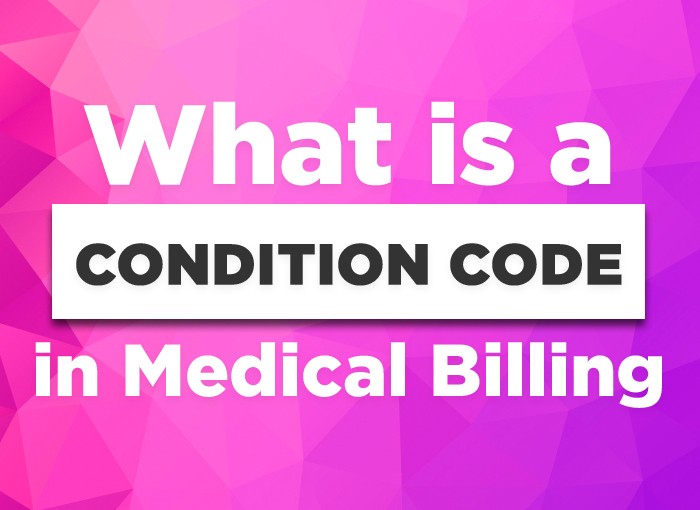What is a Condition Code in Medical Billing
The CMS-1450 form of the UB-04 form is vital in filing claims. Designed to promote uniform billing across medical institutes, the UB-04 contains 81 Form Locators (FL) fields. Each form locator demands a specific set of information that is essential to file claims. The information related to the field locators varies from payer to payer—the other payer may not require what one payer needs. While billing the payers, the medical biller fills in the required form locators. However, some form locators require extra attention as they demand to fulfill certain conditions. This is where the term Condition Code comes in. Condition codes refer to specific form locators in the UB-04 form that demand to describe the conditions applicable to the billing period. It is important to note that condition codes are situational. These codes should be entered in an alphanumeric sequence.
Definition of Condition Codes
National Uniform Billing Committee (NUBC), in its Official UB-04Data Specifications Manual 2007, defines condition codes as codes used to identify conditions or events relating to this bill that may affect processing. The form locators (FL) 18 to 28 are listed as condition codes in the CMS Manual System: Medicare Claims Processing Pub. 100-04 Chapter 25 Update (https://www.cms.gov/Regulations-and-Guidance/Guidance/Transmittals/Downloads/R2922CP.pdf).
The field attributes of condition codes described in NUBC’s manual are “11 fields, 1 line, two positions, alphanumeric, and all positions fully coded.”
Key Attributes of Condition Codes:
- Fields: 11 (FL 18–28)
- Format: Alphanumeric (2 positions)
- Sequence: Must be entered for proper claim submission
- Source: Listed and updated in theN UBC’ss Official UB-04 Data Specifications Manual
Why Are Condition Codes Important?
Condition codes provide context-specific information that helps payers understand unique circumstances associated with a claim. They ensure that payers have the information to adjudicate claims accurately, which could impact reimbursement or approval. Claims may be delayed or denied without these codes due to incomplete or unclear documentation.
Understanding the Conditions/Situations Mentioned by NUBC
The form locators from 18-28 are further divided into situations identified by sub-codes referring to and/or explaining the situation. The NUBC’s 2007 manual lists 99 situations with numeric codes ranging from 01-99. For example, sub-code 01 refers to the Military Service-Related situation explained as medical conditions incurred during military service. Sub-code 09 refers to the Patient being Homeless, which is described as the Patient being homeless. The sub-code 80 refers to a Home Dialysis-Nursing Facility home dialysis furnished in an SNF or nursing facility. The last numeric sub-codes from 81-99 are reserved for assignment by NUBC.
In addition to the numeric sub-codes, condition codes also have alphanumeric sub-codes referring/or explaining situations that are largely associated with medical programs and associated with procedures.
These alphanumeric codes are named—A0, A1, A2 […] AA, AB, AC, […] AZ, B0, B1, B2 […] W0 […] and ZZ. The sub-code A0 refers to the TRICARE External Partnership Program, which identifies TRICARE claims submitted under the External Partnership Program. Similarly, the sub-codes AA, P1, and W0 refer to Abortion Performed due to Rape, Do Not Resuscitate Order (DNR), and United Mine Workers of America (UMWA) Demonstration Indicator, respectively.
It is advisable to read NUBC’s Official UB-04Data Specifications Manual 2007 (or the latest edition) to understand the situations assigned to conditions codes.
Using the Condition Codes
While filling out the UB-04, the provider must fill out the codes in sequence. For example, if you wish to explain situations referred to in sub-codes 04 and 69, you must put them under the form locators FL18 and FL19 in sequence. So, the format will be FL18-04 and FL19-69 explaining situations. Information will only be for Bill and IME/DGME/N&AH Payment.
How to Use Condition Codes on the UB-04 Form
When completing the UB-04 form, providers must follow these steps for proper entry of Condition Codes:
1. Identify the Applicable Situations:
2. Refer to the NUBC manual to determine which condition codes apply to the claim.
3. Sequence the Codes Correctly:
4. Condition codes must be entered in alphanumeric order. For example:
- FL18: 04 (Information Only Bill)
- FL19: 69 (IME/DGME/N&AH Payment Only)
5. Verify Completeness:
6. Ensure all required condition codes are filled in the respective fields before submission.
Common Applications of Condition Codes
- Military Claims: Codes like 01 are used for service-related injuries or conditions.
- Special Billing Situations: Codes such as 80 or A0 are essential for claims involving specific facilities or programs.
- Emergency Cases: DNR orders (P1) or specific exemptions (e.g., rape or trauma cases like AA) must be explicitly mentioned to justify procedures or treatments.
Best Practices for Using Condition Codes
Consult the Latest NUBC Manual: Regular updates are made to the list of condition codes. Providers should always refer to the most recent edition of the Official UB-04 Data Specifications Manual.
Work closely with Payers: Since requirements may vary, communication with payers can help clarify which codes are mandatory for claim acceptance.
Double-Check Accuracy: Even minor sequence or code format errors can result in claim denials.
Conclusion
Condition codes are indispensable for conveying critical details about a claim that may affect its processing. Understanding and properly utilizing these codes ensures compliance with payer requirements and reduces the risk of delays or rejections. To gain a comprehensive understanding, healthcare providers are encouraged to refer to the NUBC Official UB-04 Data Specifications Manual and stay updated with changes in medical billing regulations.




